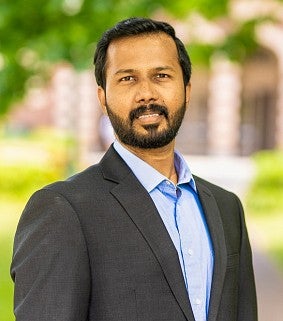
UO scientists are collaborating to build resilient communities through hazard-proof environment monitoring sensors throughout the Pacific Northwest
February 6, 2024 - 11:00am
Scattered across the Pacific Northwest, a growing network of sensors constantly monitors the environment for early warning signs of an impending natural hazard, ready to alert the public with life-saving information.
But what happens if a massive earthquake or other disaster damages the network or knocks out internet service in the area? What if the sensors fail due to a cyberattack?
Funded by a $1.2 million grant from the National Science Foundation (NSF), researchers at the University of Oregon College of Arts and Sciences are partnering with Rutgers University to answer that question while shoring up the region’s network of earthquake sensors and wildfire cameras.

“If the Cascadia earthquake happened tomorrow, it would affect a number of critical infrastructures, including the internet,” says Ram Durairajan, an associate professor in the Department of Computer Science. “If such an event happens, how can we even communicate that we’re safe? All these monitoring systems that strive to collect data about natural hazards rely on the internet. A resilient and secure internet is the backbone of these monitoring systems.”
Durairajan, who studies network resilience at the Oregon Networking Research Group, is collaborating with the Oregon Hazards Lab (OHAZ) to address vulnerabilities within the system of ShakeAlert earthquake sensors and ALERTWest wildfire cameras OHAZ has deployed throughout the Pacific Northwest. The sensors all rely on a shared IP network to deliver real-time data to monitoring and alert systems.
“We’re building out a fairly complex system of sensors, and that represents a significant amount of physical and cyber infrastructures,” says Doug Toomey, director of the Oregon Hazards Lab and a professor in the Department of Earth Sciences. “If there’s a failure in the system, how can we route around the damage?”
Durairajan’s team is developing an interdisciplinary framework for identifying and mitigating potential threats to the monitoring system, from physical damage to cybersecurity attacks. Known as HazardMon, the framework will monitor all aspects of the system, including the hardware that collects data in the field, the cloud-based data center where information is routed before landing in back-end servers for processing, and the internet network that connects them all.
“We monitor the monitors. That’s our punchline here,” Durairajan says.
Early detection of environmental hazards such as earthquakes and wildfires can help communities quickly mobilize and save lives, Toomey says. Hazard monitoring systems such as the network OHAZ has built play a critical role in increasing community resilience against these hazards.
“We can take protective action when we know something is coming,” he says. “We know earthquakes have an impact on the resilience of the internet, and since our goal is to alert communities about earthquakes, we should probably look at the tool that alerts us.”

The potential impact of Durairajan’s project extends far beyond the Pacific Northwest. His team plans to open-source HazardMon, allowing scientists and stakeholders to apply its solutions to other hazard monitoring systems throughout the world. They are also collaborating with the NSF project, which aims to build a continent-spanning network of smart sensors to help scientists collect data from the natural world.
“In the US alone, there are at least a dozen systems like ShakeAlert and ALERTWest that could benefit from HazardMon,” Durairajan says. “In theory, what we’re doing is applicable to all those other systems out there. We have a number of natural hazards we’re monitoring in this country and in different parts of the world.”
Durairajan hopes the project will spark community engagement and help catalyze larger, multi-stakeholder partnerships to combat the effects of climate change.
“This is beyond what an individual community can do today,” he says. “The framework we are developing will culminate in better tools to combat geohazards and climate change-related disasters. These are among the most significant threats to humanity.”
—By Nicole Krueger, College of Arts and Sciences
—Top photo: Members of the Oregon Hazards Lab deploy sensors in the field to collect data from the environment and monitor for natural hazards.
